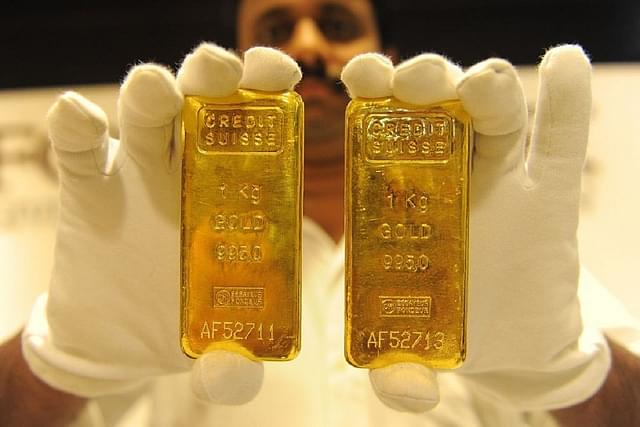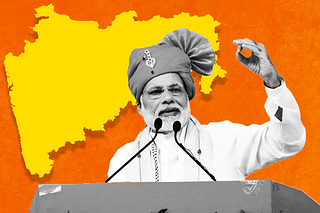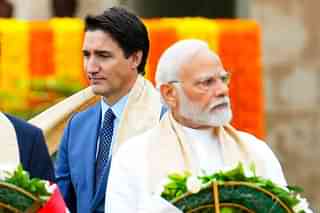Ideas
Government Must Rethink Gold Bonds Scheme; It Must Not Take On Risks Best Left To Private Investors
R Jagannathan
Dec 18, 2023, 10:16 AM | Updated 10:16 AM IST
Save & read from anywhere!
Bookmark stories for easy access on any device or the Swarajya app.

India’s romance with gold is probably as old as recorded history. Governments in India, and also many western governments, have tried every possible means to rewire gold investors and buyers, but to little or no avail.
While the official Indian frown on physical gold holdings is largely driven by balance of payments considerations, the western world, especially the US, thinks a rising gold price is a comment on their macroeconomic failures — which is true — to hold fiat currency values steady.
The question to ask is whether governments must bet against the tide of human wisdom accumulated through the ages?
It is in this context that we must view India’s sovereign gold bonds (SGBs) scheme, the latest tranche of which opened today (18 December). Priced at Rs 6,149 per gm, it is Rs 276 pricier than the last tranche in September (Rs 5,873).
These bonds will receive 2.5 per cent interest per annum, which is taxable and payable half-yearly, but they are exempt from capital gains if held for the full eight-year tenure till maturity.
Remember, even though the interest is taxable, physical gold pays no interest whatsoever, and may, in fact, incur a small cost since large holdings will have to be kept in safe deposit lockers.
Contrast this latest sale price with what investors paid in the very first issue of SGBs in 2016. They paid just Rs 2,684 per gm, and were given back Rs 6,132 when the bonds were redeemed on 30 November this year. That’s an overall return of over 128 percent without counting interest.
It’s a compounded annual growth rate (CAGR) of just under 11 per cent. Take the interest element, which was higher at 2.75 percent in 2016, and the CAGR could be as much as 13 per cent.
At this level of return, and that too tax-free, gold returns are not too far off from stock market returns — without the default and other risks. Till September, large cap stocks in India delivered 10.9 per cent CAGR over a 10-year period, most of it backloaded to the last few years.
Even taking the recent sharp rise in stocks, which could yet end up in a correction in the coming weeks, this does not show gold in poor light at all. Indian stocks did better than world indices, but so did Indian gold prices.
Do India’s gold bugs know something that policymakers don’t? You bet. And if you accept this argument, we must ask the question: why give them higher returns than what the market would, and at low risk? Is it the government’s job to help gold investors make money?
A few points, caveats, and counters are in order.
First, the current huge returns on SGBs can correct if gold prices fall. In fact, the government gains only if that happens. But consider the data. According to goldprice.org (see table at bottom of a long web page), there is almost no country in the last 15-year period which reported a gold price return lower than local inflation, and India’s returns were at a healthy 11.5 per cent.
Second, excluding the latest SGBs that are now open for subscription till 22 December (another one is due in February 2024), India has issued the equivalent of over 120 tonnes of paper gold. But consider what the central bank, which issues these bonds, has been doing itself.
In July-September 2023, it bought nine tonnes of gold for its reserves. Other central banks, including China and Turkey, have been doing the same. Why ask people to hold paper gold when your own actions speak otherwise?
Three, one point made in SGBs' favour could be that it helps reduce physical imports of gold. But that already happens when prices rise. And actual rupee import costs of gold were higher in fiscal 2021-22 (Rs 3.4 lakh crore) compared to fiscal 2016-17 (1.8 lakh crore), when SGBs were first introduced.
The physical drop in imports is the result of the price rise, not necessarily the issue of paper gold in its stead. In fact, allowing physical gold makes the government richer on taxes, as the import tax is 15 per cent plus.
Four, one trigger is the US decision to block Russia’s foreign exchange reserves after it attacked Ukraine last year. But the message it has sent to other countries that feel similarly threatened by US sanctions is that the US cannot be trusted to maintain the financial integrity of the markets, especially on dollar reserves and assets held in the US or NATO countries. In fact, many countries are now repatriating gold to their own jurisdictions, for fear that even their physical gold reserves can be seized.
So, it is possible that if the Ukraine and West Asian wars end some time in 2024 (we have no hope of knowing if that will happen, or whether the wars will widen to involve other players), gold prices could cool off. But central banks, and individuals, are unlikely to place all their eggs in the dollar basket in future — it is no longer a safe haven if your relationship with Uncle Sam is rocky.
The case for a rethink on the issue of SGBs is simply this: why should the government reward a risky investment bet which should ideally be a private affair? That history has been on the side of gold buyers is no reason why SGBs should not be re-evaluated for a cost-benefit analysis.
India should not bet against long-term conventional wisdom on gold. Before you know, ordinary people who were always willing to shoulder this risk, may demand MSPs for gold too! One should not bet on the wisdom on India's opposition politicians not making this demand, if there is even one tranche that loses big money for the investor due to wrong timing on redemption.
Save & read from anywhere!
Bookmark stories for easy access on any device or the Swarajya app.
Jagannathan is Editorial Director, Swarajya. He tweets at @TheJaggi.
Introducing ElectionsHQ + 50 Ground Reports Project
The 2024 elections might seem easy to guess, but there are some important questions that shouldn't be missed.
Do freebies still sway voters? Do people prioritise infrastructure when voting? How will Punjab vote?
The answers to these questions provide great insights into where we, as a country, are headed in the years to come.
Swarajya is starting a project with an aim to do 50 solid ground stories and a smart commentary service on WhatsApp, a one-of-a-kind. We'd love your support during this election season.
Click below to contribute.





